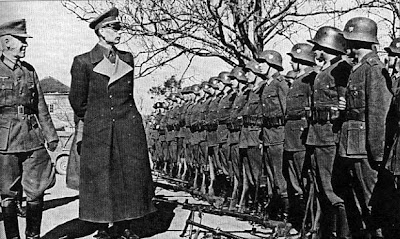Some collaborators of the Second World War served a strictly military purpose or role, like the conscript and volunteer legions of Denmark, Sweden, and the Belgian and Dutch who fought in the Wehrmacht or in the Waffen-SS. If an occupied or even enemy nation had manpower to offer up to the Nazis often accepted, politically and strategically speaking this was often advantageous.
A variety of factors and needs must have created the desire to recruit non German regiments, cultural and ethnic divisions or hatred in actual fact was apart of this, as was a general fear of communism. Perhaps the Nazi's brand of brutality alone motivated others.
For the Third Reich collaboration served an equally important propaganda role in furthering their own twisted ideologies of racial purity and the like. Of course militarily speaking they helped to fulfill a manpower shortage needed by the Nazi high command for service on the Eastern Front originally. The Waffen-SS was invaluable because it used these forces for a variety of purposes from special forces, to simple guard units, to more specialized roles as sappers or grenadiers, or even for more sinister purposes, well documented by the crimes of the Waffen-SS and its Schutzstaffel parent organization. Many of these operations involved genocide either apart of or euphemistically refereed to as anti-partisan duty.
In the Scandinavian countries especially, the Nazi partly realized some of their racial and cultural goals in the New European order by forming SS or regular army units like the Viking and Nordland divisions filled with Nordic, “Aryan” soldiers. Some Frenchmen served in the Wehrmacht including a few elite and highly decorated members of the Charlemagne division who later became Waffen-SS grenadier/tank hunters who defended Berlin in April of 1945.
A variety of factors and needs must have created the desire to recruit non German regiments, cultural and ethnic divisions or hatred in actual fact was apart of this, as was a general fear of communism. Perhaps the Nazi's brand of brutality alone motivated others.
For the Third Reich collaboration served an equally important propaganda role in furthering their own twisted ideologies of racial purity and the like. Of course militarily speaking they helped to fulfill a manpower shortage needed by the Nazi high command for service on the Eastern Front originally. The Waffen-SS was invaluable because it used these forces for a variety of purposes from special forces, to simple guard units, to more specialized roles as sappers or grenadiers, or even for more sinister purposes, well documented by the crimes of the Waffen-SS and its Schutzstaffel parent organization. Many of these operations involved genocide either apart of or euphemistically refereed to as anti-partisan duty.
In the Scandinavian countries especially, the Nazi partly realized some of their racial and cultural goals in the New European order by forming SS or regular army units like the Viking and Nordland divisions filled with Nordic, “Aryan” soldiers. Some Frenchmen served in the Wehrmacht including a few elite and highly decorated members of the Charlemagne division who later became Waffen-SS grenadier/tank hunters who defended Berlin in April of 1945.
Officer of Pioneer Companie 33, French Waffen SS unit, April 1945, Berlin
from Osprey's Waffen SS (4) Volunteer Legions
On the Eastern Front the Nazi’s further exploited the Ukrainians and the Cossacks cultural and historical hatred for the Czars and the Soviets, dating back to the Civil War and its aftermath, to raise a fairly large army of Russian-Slavic peoples, the most significant being the Russian Liberation Army under General Andrey Vlasov, a former Red Army general who had fought the Nazi’s before defecting in 1942.
General Vlasov reviewing his puppet army under the supervision of a Wehrmacht officer
British Free Corps officer of 1944-1945
Waffen SS Foreign Volunteer Legions
- 33rd Waffen division Grenadiers 'Charlemagne'-French
- 7th Mountain Division (anti-partisan) 'Prinz Eugen'-Yugoslov and former Austro-Hungarian territories
- 27th Grenadier division 'Langemarck'-Flemish
- 11th Volunteer Panzer Grenadier 'Nordland' Divisions-Norway and other Aryan nations
- Denmark
- Netherlands
- 14th Grenadier Division-Polish & White (Monarchist, anti-Soviet) Russians
- Latvian Volunteers
- Estonian Grenadiers
- Albanian Mountain Division (anti-partisan)
- Hungarian Grenadiers
- 'Walloons'-Belgium
- Russian Grenadiers
- Italian fascist Grenadiers
- XIV Cossack Cavalry corps-Don Cossack
- Norweigan volunteers
- Indian Legion




